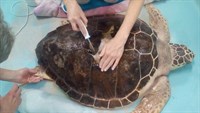
This week we’re covering the basics of rehabilitation – getting sick and injured sea turtles back home. Most of the sick and wounded coming through our doors can generally be grouped into a few categories: predatory (shark or other natural enemy), human interaction (boat strike, prop wounds and fishing gear entanglement), pollution of their habitat (plastic waste, litter, toxic chemicals, balloons), cold-stuns (hypothermia) and finally the “Barnacle Bills,” the trickiest to treat. Barnacle Bill turtles are just what you might imagine: they’re covered everywhere (carapace, plastron, head and flippers) with barnacles, algae, leeches – if it’s in the water and can attach itself to a slow-moving turtle they’ve got it on them. And mud. It’s not until you wash off all the mud and other gunk that you can really determine if there are injuries underneath.
Turtles arriving without paperwork are evaluated, measured, weighed and the stranding information required by the federal government for Endangered Species is completed. Any turtles accompanied by that paperwork can skip the weighing, measuring etc. All new patients are admitted to Sea Turtle Sick Bay where they are quarantined in individual tanks for a minimum of forty days per US Fish & Wildlife regulations. These patients need critical care treatment by our staff. They are sick, stressed and need the relative quiet of a small room and a small tank to keep them calm. They are treated daily, sometimes twice a day. Most often they are taken out of their tanks for the treatment, which starts with a soapy bath, thorough rinse and additional flushing of wounded areas with syringes of saline (or sterile water.) Once they are clean and dry we apply a betadine solution (think the old orang-y iodine) as an all-over wash, as well as further flushing of any wounds. Betadine helps to reduce bacterial infection. A clean turtle is a happy turtle, and they smell a lot better, too!
From that point the treatments can take many forms depending on why a turtle is here. Some turtles are placed on protocols of oral and/or injected antibiotics. Some turtles are severely anemic and dehydrated and need IV fluids, including liquid vitamin supplements. Many turtles are radiographed (x-rayed) to look for foreign objects such as fish hooks, broken bones and things like bone lesions. These radiographs are very helpful with the diagnosis, prognosis and treatment of the turtles. Other medications are administered as prescribed and include things such as anti-fungal and parasitic treatments. Alarmingly, we are seeing more and more patients who are showing resistance to treatments that should work to clear up infections – just like what’s happening to us humans. Clearly years of flushing outdated meds down the drain which eventually end up in our oceans is not a smart plan.
Topical treatment of wounds range from simple application of a little triple antibiotic cream to hour-long sessions spent in a tank or on the lab table. Sometimes the spinal cord and internal organs are exposed and need the gentlest of hands and the absolute undivided attention of our volunteers to keep from doing further damage. A water pick can be used to flush dirt and other debris from deep wounds. Once cleaned the exposed areas are covered with one of our miracle salves, SSD, Silver Sulfadiazine, an antibiotic that fights bacteria and yeast. Large, open wounds are covered with a Tegaderm dressing to keep the area dry between treatments.
Sometimes we use nature to help heal our turtles. Several years ago (with the approval of Dr. Harms) we began to treat wounds with honey, and we happened to have a source for the unaltered stuff right out of the hive. Nancy Fahey (hospital volunteer and Director of Wrightsville Beach Sea Turtle Project) brought us jars from her father’s hives. (You might remember a previous story we did on him and how we use his honey.) The honey treatment is very time-consuming, a minimum of thirty minutes and up to an hour. A volunteer has to sit with the turtle and sometimes re-apply honey as it seeps into the wound and works its magic. Not all turtles get this sweet treatment, sometimes it’s just not applicable to their condition, but we can attest to the remarkable healing powers of this golden goo. In fact, we now have two hives of our own so when we need honey it’s just a short walk away!
Of course there are the exceptions and special cases that require not only our extensive experience but also our willingness to learn how to use new applications. Years ago, in the old hospital, we learned the value of physical therapy for sea turtles. Flippers that are stiff from injury, muscle atrophy and scar tissue can regain an acceptable range of motion when our staff performs turtle-like movements on them daily. And these critters also get about thirty minutes of swim time in the therapy pool to go along with the manual manipulation. Last year we began cold laser therapy on selected patients, again under the guidance of Dr. Harms. Remember that article? Results have exceeded our expectations and we continue using the therapy on turtles not only with bone lesions, but certain other types of wounds.
While not all injuries or illnesses can be treated without advanced medical intervention (surgery and cataract removal for example) the turtles still come to us for their after-procedure care. People often ask how long turtles stay with us. It depends on why and when they arrived. Sometimes it’s a matter of days, and sometimes they’re with us for years. When a turtle is off daily treatments and has been cleared by Dr. Harms to move to the “big house” (Sea Turtle Bay) they still receive daily care (lots of TLC, food, supplements and cleaning) by our volunteers. These are the turtles you see from our observation ramp during your visit. It’s their final stop before going home, and we’ll cover that, the release, next time.
By Karen Sota, media coordinator for the Karen Beasley Sea Turtle Rescue and Rehabilitation Center


